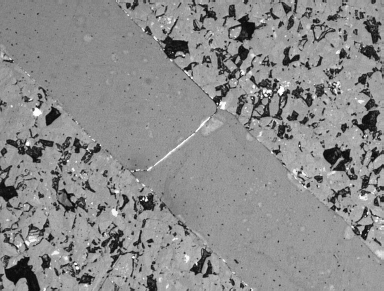

A technique of shear deformation developed earlier by Karato and Rubie (1997) has been modified and applied to several deep mantle minerals. Major objectives of this project include (i) determination of texture (lattice preferred orientation) development in deformed deep mantle minerals, (ii) investigation of relative strength differences between different materials or the same materials with different grain-sizes, and (iii) identification of deformation mechanisms. Major recent modifications include: (i) extension to higher pressures using a 5000 tonne press (to ˜21 GPa) to investigate deformation behavior of materials under deeper Earth conditions, and (ii) use of samples with a wider range of grain-sizes to obtain a better understanding of the role of grain-size in deformation. Electron BackScattered Diffraction (EBSD) is being used to investigate the fabric development in deformed samples.
A larger sample size, which is critical for deformation studies, may be obtained in experiments performed in the 5000 tonne press. Two successful deformation experiments were conducted on akimotoite (silicate ilmenite) at ˜ 20 GPa and ˜ 1500°C. We find little reaction between sample and (alumina) pistons and shear strains were small but significant ˜10-30% after 2-7 hour runs (Fig. 3.1-22). Deformed akimotoite shows a very strong fabric, consistent with a large mechanical anisotropy for this material. The details of the fabrics and the mechanisms of fabric development are under investigation.
We have made progress toward quantifying deformation mechanism maps for wadsleyite and ringwoodite. We focus on determining the critical grain-size at which a change from grain-size sensitive (diffusion) creep to grain-size insensitive (dislocation) creep occurs at a given set of conditions.
A two-layer deformation experiment was performed on ringwoodite (Fe/(Mg+Fe) = 40%). The experiment was conducted at ˜15 GPa and T=1200°C for 3 hours with initial grain-sizes of ˜2 and ˜7 microns. After deformation the strains measured in the two layers were nearly identical at ˜120%. Measurement of the grain sizes in the samples after the experiment revealed nearly identical grain-sizes. However, using a grain-growth law to interpolate grain-size, we conclude that the critical grain-size of the transition between dislocation and diffusion creep must be 2 micron or less, otherwise a significant difference in strain would develop. This result is consistent with Karato et al. (1998) who inferred the critical grain-size for ringwoodite to be ˜ 1-2 microns under similar experimental conditions.
A similar experiment was conducted for wadsleyite (Fe/(Mg+Fe) ˜10%) at ˜15 GPa and 1200°C, where two samples with starting grain sizes of 1-2 microns and 3-6 microns were deformed simultaneously. In this case, we find a significant difference in strain, the strain in a fine grained layer is larger than that in a coarser grained layer by a factor of 3. However, the magnitude of this difference is significantly smaller than what one expects from a simple model of diffusional creep. Therefore we conclude that the transition grain-size is likely to be between 2-5 microns for wadsleyite under these conditions. Relatively strong fabrics seen in both layers also indicate that both samples deformed under conditions not far from the transition to grain-size sensitive creep.
We have also deformed a range of (Mg,X)O (with X=Fe, Ni) samples. We noted a marked effect of Fe in reducing the plastic strength: samples with a higher Fe content deformed more than a sample with a smaller Fe content. To investigate the possible role of pressure in changing the dominant slip systems, we have performed a series of deformation experiments on FeO at pressures ranging from ˜10 to ˜16 GPa. Microstructural analysis has been performed using TEM and SEM to investigate the dominant slip systems and resulting fabric developments.
 |
Fig: 3.1-22: Sample of akimotoite (ilmenite spinel) with Pt strain marker sandwiched between Al2O3 pistons deformed at 20 GPa and 1500°C. |

Tel: +49-(0) 921 55 3700 / 3766, Fax: +49-(0) 921 55 3769, E-mail: bayerisches.geoinstitut(at)uni-bayreuth.de
 Previous page
Previous page